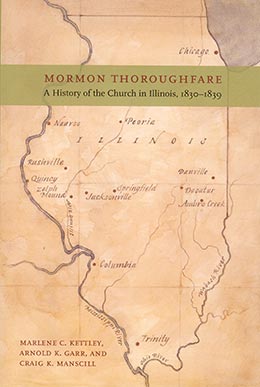Preface
Marlene C. Kettley, Arnold K. Garr, and Craig K. Manscill
Marlene C. Kettley, Arnold K. Garr, and Craig K. Manscill, preface to Mormon Thoroughfare: A History of the Church in Illinois, 1830–39 (Provo, UT: Religious Studies Center, Brigham Young University, 2006), vii–vii.
Marlene C. Kettley was a researcher and historian, Arnold K. Garr was chair of the Department of Church History and Doctrine at Brigham Young University, and Craig K. Manscill was an associate professor of Church History and Doctrine at Brigham Young University when this was published.
This project—a history of the Latter-day Saints in Illinois, 1830–39—began when Marlene C. Kettley sought information about her husband’s ancestors who came to Illinois state during the early nineteenth century. While researching, she found numerous references to early Mormon missionaries and other members of The Church of Jesus Christ of Latter-day Saints which caught her attention. In 1985, Robert E. Fisher, then president of the Naperville Illinois Stake, asked her to compile information on the history of the stake. She remembered those early references. As Marlene continued her research, she was surprised to learn that some of those early elders, who had been sent to Independence, Missouri, in 1831 in response to section 52 of the Doctrine and Covenants, had taught and baptized within what would become the boundaries of the Naperville Stake. She also discovered that the first Latter-day Saint branch in Illinois, established in 1831, was located near the present-day Naperville Illinois Stake Center. While she was researching old county histories and journals of the early Saints, it soon became obvious that the Church had established numerous branches throughout the state during the 1830s. Marlene discovered that as early as 1835 The Church of Jesus Christ of Latter-day Saints was likely the fourth largest religious body in Illinois. Local histories, newspapers, and private journals soon added detail and color to the statistics. Before long, Marlene’s research went far beyond the boundaries of the Naperville Stake and ultimately expanded throughout the entire state of Illinois.
In 2003, Arnold K. Garr and Craig K. Manscill, professors of Church history and doctrine at Brigham Young University, joined Marlene as coauthors. They soon realized that sources available at BYU could strengthen the work.
Not only does this book unveil many previously unknown events in Church history that took place in Illinois, but it also utilizes many county and community sources that provide a non–Latter-day Saint as well as a Latter-day Saint perspective. The authors have also placed many important Latter-day Saint developments within the context of Illinois state history.
The authors would like to thank several people who gave valuable assistance in helping to produce this work. They are especially grateful to their spouses and children for their loving support. This project would have died an untimely death without the help of Marlene’s husband, William, who gladly traveled the extra mile in word and deed. He acted as travel agent and chauffeur when Marlene traveled extensively throughout Illinois. Arnold’s wife, Cherie, and Craig’s wife, Jana, also demonstrated remarkable kindness and understanding during the project. They never complained on those occasions when their husbands were working late at the office.
The authors would also like to thank Ronald O. Barney, senior archivist at the Latter-day Saint Family and Church History Department in Salt Lake City, who was the first to encourage the publication of this work and who reminded them of the importance of careful documentation. Others at Church Archives who gave assistance were Ronald G. Watt, W. Randall Dixon, and James L. Kimball Jr. They gave much guidance and support throughout the project. Valued friends Vivian McConkie Adams and Lou Anne Clark Mallory have long shown confidence in this project. In addition, M. Dell Madsen spent hours reading early drafts of the manuscript and encouraged its completion.
In addition, the authors would like to express appreciation to BYU professors Andrew C. Skinner, then dean of Religious Education; Richard D. Draper, associate dean of Religious Education; and Paul H. Peterson, chair of the Department of Church History and Doctrine, for their support. The writers gratefully acknowledge the efforts of those in the Religious Studies Center who helped prepare this work for publication—Richard Neitzel Holzapfel, managing director; R. Devan Jensen, executive editor; and Charlotte A. Pollard, office manager.
